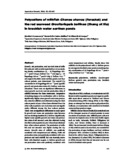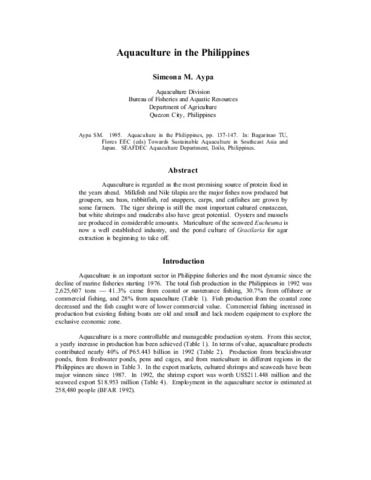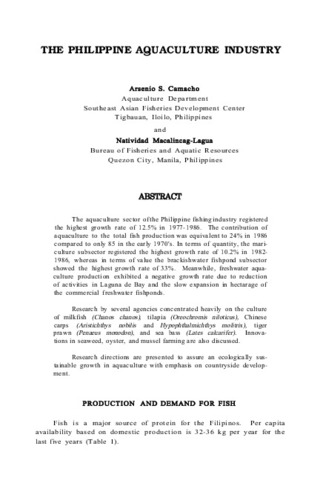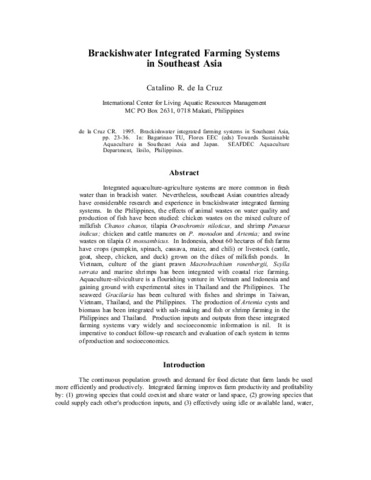Polyculture of milkfish Chanos chanos (Forsskal) and the red seaweed Gracilariopsis bailinae (Zhang et Xia) in brackish water earthen ponds

View/Open
Date
2004Page views
254Metadata
Show full item recordCited times in Scopus
37 readers on Mendeley
- Citations
- CrossRef - Citation Indexes: 9
- Policy Citation - Policy Citations: 1
- Scopus - Citation Indexes: 11
- Captures
- Mendeley - Readers: 36
Share
Abstract
Growth, net production, and survival rates of milkfish cultured with Gracilariopsis bailinae at two stocking density combinations (T1– 30 fingerlings 100-m−2 pond+1-kg G. bailinae 4-m−2 net cage, T2– 30 fingerlings 100-m−2 pond+2-kg G. bailinae 4-m−2 net cage) in brackish water earthen ponds over four culture periods were determined. The control (T3) was stocked at 30 fingerlings 100-m−2 pond. Specific growth and production rates of G. bailinae were also calculated. There were no significant differences in mean growth, survival, and net production rates of milkfish between the three treatments. Irrespective of stocking singly or in combination with G. bailinae, significantly higher mean growth and mean production rates for milkfish were obtained during the third culture period of year 1 than those obtained from the other culture periods. Survival rates were not significantly different among the four culture periods. There were no significant differences in mean specific growth and mean net production rates between the two stocking densities of G. bailinae. Significantly higher mean specific growth and mean net production rates of red seaweed were also obtained during the third culture period of year 1 than those obtained from other culture periods. The production of milkfish and red seaweed was higher during the dry season. Growth rates of milkfish was positively correlated with temperature and salinity, while net production rates were positively correlated with temperature and total rainfall, but was inversely correlated with dissolved oxygen. G. bailinae growth and net production rates were positively correlated with water temperature and salinity. Results show that milkfish can be polycultured with G. bailinae grown in net cages in brackish water ponds at stocking density combination of 30 fingerlings 100-m−2 pond+1-kg G. bailinae 4-m−2 net cage.
Suggested Citation
Guanzon, N. G., Jr., de Castro-Mallare, T. R., & Lorque, F. M. (2004). Polyculture of milkfish Chanos chanos (Forsskal) and the red seaweed Gracilariopsis bailinae (Zhang et Xia) in brackish water earthen ponds. Aquaculture Research , 35(5), 423-431. https://doi.org/10.1111/j.1365-2109.2004.01001.x
Subject
aquaculture; cage culture; cages; dissolved oxygen; dry season; fish culture; growth rate; polyculture (aquaculture); ponds; rainfall; salinity effects; seaweed culture; seaweeds; stocking density; survival; temperature effects; water temperature; yields; Rhodophyta; milkfish; Chanos chanos; Philippines
Taxonomic term
Collections
- AQD Journal Articles [1248]
Related items
Showing items related by title, author, creator and subject.
-
Aquaculture in the Philippines
Aypa, Simeona M. (Aquaculture Department, Southeast Asian Fisheries Development Center, 1995)Aquaculture is regarded as the most promising source of protein food in the years ahead. Milkfish and Nile tilapia are the major fishes now produced but groupers, sea bass, rabbitfish, red snappers, carps, and catfishes ... -
The Philippine aquaculture industry
Camacho, Arsenio S.; Macalincag-Lagua, Natividad (Aquaculture Department, Southeast Asian Fisheries Development Center, 1988)The aquaculture sector of the Philippine fishing industry registered the highest growth rate of 12.5% in 1977-1986. The contribution of aquaculture to the total fish production was equivalent to 24% in 1986 compared to ... -
Brackishwater integrated farming systems in Southeast Asia
De la Cruz, Catalino R. (Aquaculture Department, Southeast Asian Fisheries Development Center, 1995)Integrated aquaculture-agriculture systems are more common in fresh water than in brackish water. Nevertheless, southeast Asian countries already have considerable research and experience in brackishwater integrated farming ...




